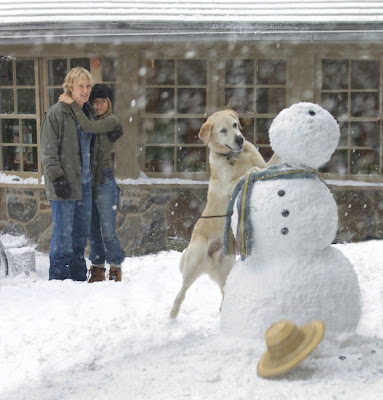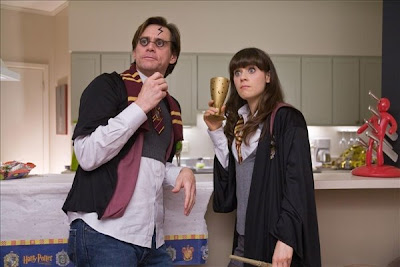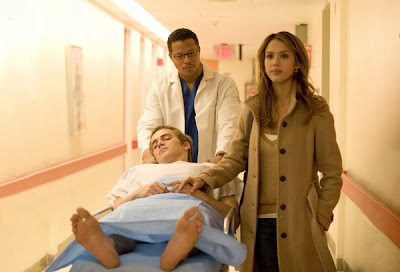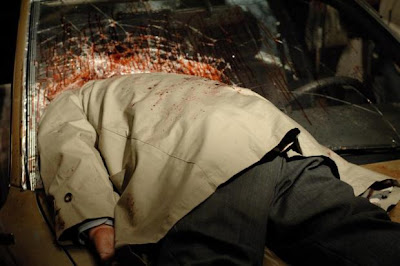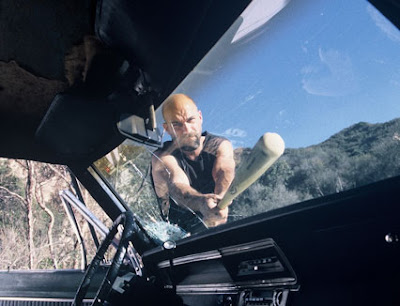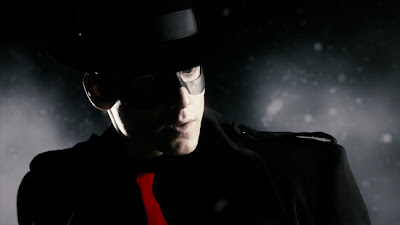
The Spirit/Denny Colt: Gabriel Macht
The Octopus: Samuel L. Jackson
Sand Saref: Eva Mendez
Ellen Dolan: Sarah Paulson
Silken Floss: Scarlett Johansson
Pathos, etc.: Louis Lombardi
Commissioner Dolan: Dan Lauria
Morgenstern: Stana Katic
Lorelei Rox: Jamie King
Plaster of Paris: Paz Vega
Arthur the cat: Himself
Lionsgate presents a film written and directed by Frank Miller. Based on the comic book series by Will Eisner. Running time: 103 min. Rated PG-13 (for intense sequences of stylized action and violence, some sexual content and brief nudity).
One of the posters for “The Spirit”—the new movie adaptation of a 1940’s style comic book series—depicts an artistic rendering of the titular hero drawn by the film’s writer/director Frank Miller, with the title of the film reading “Will Eisner’s The Spirit”. Eisner’s comic book was a sort of goofy, somewhat comedic take on the pulp noir heroes of that era. As envisioned here by Miller, The Spirit seems to inhabit the same hellish black and white noir universe as the characters in his and Robert Rodriguez’s 2005 film “Sin City” and might be more accurately titled “Frank Miller’s The Spirit”.
In “Sin City”, Rodriguez and Miller wrote a new cinematic language, creating a noir nightmare with harsh lines of shadow and light in a black and white world where only splashes of color where found as characterizing features—one man’s shoes were red, a certain girl had blue eyes, another was entirely in color, the blood flowed in bold red and white, and the Yellow Bastard was yellow. Miller returns to this same production design style, using the same filming techniques of shooting the actors on green screen with minimal props and set pieces, filling in the backgrounds and details in digitally after the fact. The effect in “Sin City” was like a comic book page come to life, and while the process continues to makes a bold statement and provide stunning visuals, Miller has transferred Eisner’s characters into his own universe where they don’t quite feel at home.
The Spirit (Gabriel Macht, “American Outlaws”) is ex-cop Denny Colt, who somehow cheated death and returned with invulnerability to most wounds making him possibly immortal, although death in the form of Lorelei Rox (Jamie King, “Gary Unmarried”) is always waiting close by to finally embrace him. He abandoned his former life to become Central City’s protector and developed a reputation as a ladies man. He works with but separate from the police force, an arrangement that doesn’t sit well with Commissioner Dolan (Dan Lauria, “The Wonder Years”) on the surface. This is perhaps because one of The Spirit’s squeezes is Dolan’s daughter Dr. Ellen Dolan (Sarah Paulson, “Studio 60 Live on the Sunset Strip”).
The story picks up when a childhood flame turned jewel thief, Sand Saref (Eva Mendez, “The Women”), returns to Central City in a scheme that seems to involve The Spirit’s arch nemesis The Octopus. Samuel L. Jackson (“Jumper”) plays The Octopus as a Samuel L. Jackson character and seems to exist expressly for the purpose of beating the snot out of the invulnerable hero. He is accompanied by a sexy, yet apparently asexual assistant Silken Floss (Scarlett Johansson, “Vicky Christina Barcelona”) and an army of clone goons (all played to moronic perfection by Louis Lombardi, “24”).
It appears as if The Octopus was written by Miller to be played only by Jackson, since the character so blatantly embraces all the characteristics Jackson has become famous for, such as demeaning those around him with his intelligent quips and bracing delivery. Or it could be that Jackson is simply aware that his particular brand of delivery is the primary reason people come to see him. He has fun with it however absurd it makes his character.
There is a great deal of humor in the script, but it must struggle its way to the surface, fighting through the dark atmosphere established by the stylized environment of the black and white world. Miller does allow much more color into his camera than he and Rodriguez did in “Sin City”, but hardly enough to capitalize on the colorful humor that could have shined through in a brightly lit movie. It’s strange that Miller chose to mirror his “Sin City” material with Eisner’s characters, since Eisner’s book was always painted with a bright and broad palate of color.
Miller also struggles with the pacing of the film. There are times when he seems to admire the spectacular images he creates too much, lingering on many of them for too long and returning to them too often. One image of a girl silhouetted in red as she walks away is cut to three times when once would have been more effective. The pace is also slowed down when The Spirit stops to talk to himself instead of placing all of his exposition in voice over. Not only is it awkward to have the hero talking to himself, but also voice over allows the action to continue while the exposition is laid down. Or perhaps he is talking to the cat that seems to exist only to follow The Spirit around.
Another thing Miller seems to have forgotten without Rodriguez there to guide him is that when you ask your audience to accept such a foreign world as the ones created in “Sin City” and here, it is very important that the environments are consistent. The movie opens with a fight between The Spirit and The Octopus. It appears to start out in a body of water, like a river or a lake. Midway through the fight it seems to become a sludge pit, much like the tar pit scene from “Sin City”. Then it turns back into water. Finally, the two finish their fisticuffs on a smooth yet solid surface of mud. This is a distracting way to begin such a stylized movie.
It also seems as if the PG-13 rating is something that was imposed upon Miller and has a restricting effect on the material he wanted to include. There is a joke involving Miller’s own decapitated head that is almost lost by the fact that the head only appears on the border of the screen. In an effort to avoid depicting the gore of the decapitation, it is becomes impossible to tell that the head is severed at all.
For those paying close attention there may be plenty of material here to keep them interested. Miller has included a great deal of detail and referencing to influences both from the comic book world and cinematically. He also proves that he can take on a solo project and still provide the stunning cinematic images equal to the graphic work he has produced for comic books. “The Spirit” isn’t a terrible movie. It just doesn’t live up to the ambition that inspired it. To some it will provide what they are looking for. To most it will only provide bewilderment.
The Octopus: Samuel L. Jackson
Sand Saref: Eva Mendez
Ellen Dolan: Sarah Paulson
Silken Floss: Scarlett Johansson
Pathos, etc.: Louis Lombardi
Commissioner Dolan: Dan Lauria
Morgenstern: Stana Katic
Lorelei Rox: Jamie King
Plaster of Paris: Paz Vega
Arthur the cat: Himself
Lionsgate presents a film written and directed by Frank Miller. Based on the comic book series by Will Eisner. Running time: 103 min. Rated PG-13 (for intense sequences of stylized action and violence, some sexual content and brief nudity).
One of the posters for “The Spirit”—the new movie adaptation of a 1940’s style comic book series—depicts an artistic rendering of the titular hero drawn by the film’s writer/director Frank Miller, with the title of the film reading “Will Eisner’s The Spirit”. Eisner’s comic book was a sort of goofy, somewhat comedic take on the pulp noir heroes of that era. As envisioned here by Miller, The Spirit seems to inhabit the same hellish black and white noir universe as the characters in his and Robert Rodriguez’s 2005 film “Sin City” and might be more accurately titled “Frank Miller’s The Spirit”.
In “Sin City”, Rodriguez and Miller wrote a new cinematic language, creating a noir nightmare with harsh lines of shadow and light in a black and white world where only splashes of color where found as characterizing features—one man’s shoes were red, a certain girl had blue eyes, another was entirely in color, the blood flowed in bold red and white, and the Yellow Bastard was yellow. Miller returns to this same production design style, using the same filming techniques of shooting the actors on green screen with minimal props and set pieces, filling in the backgrounds and details in digitally after the fact. The effect in “Sin City” was like a comic book page come to life, and while the process continues to makes a bold statement and provide stunning visuals, Miller has transferred Eisner’s characters into his own universe where they don’t quite feel at home.
The Spirit (Gabriel Macht, “American Outlaws”) is ex-cop Denny Colt, who somehow cheated death and returned with invulnerability to most wounds making him possibly immortal, although death in the form of Lorelei Rox (Jamie King, “Gary Unmarried”) is always waiting close by to finally embrace him. He abandoned his former life to become Central City’s protector and developed a reputation as a ladies man. He works with but separate from the police force, an arrangement that doesn’t sit well with Commissioner Dolan (Dan Lauria, “The Wonder Years”) on the surface. This is perhaps because one of The Spirit’s squeezes is Dolan’s daughter Dr. Ellen Dolan (Sarah Paulson, “Studio 60 Live on the Sunset Strip”).
The story picks up when a childhood flame turned jewel thief, Sand Saref (Eva Mendez, “The Women”), returns to Central City in a scheme that seems to involve The Spirit’s arch nemesis The Octopus. Samuel L. Jackson (“Jumper”) plays The Octopus as a Samuel L. Jackson character and seems to exist expressly for the purpose of beating the snot out of the invulnerable hero. He is accompanied by a sexy, yet apparently asexual assistant Silken Floss (Scarlett Johansson, “Vicky Christina Barcelona”) and an army of clone goons (all played to moronic perfection by Louis Lombardi, “24”).
It appears as if The Octopus was written by Miller to be played only by Jackson, since the character so blatantly embraces all the characteristics Jackson has become famous for, such as demeaning those around him with his intelligent quips and bracing delivery. Or it could be that Jackson is simply aware that his particular brand of delivery is the primary reason people come to see him. He has fun with it however absurd it makes his character.
There is a great deal of humor in the script, but it must struggle its way to the surface, fighting through the dark atmosphere established by the stylized environment of the black and white world. Miller does allow much more color into his camera than he and Rodriguez did in “Sin City”, but hardly enough to capitalize on the colorful humor that could have shined through in a brightly lit movie. It’s strange that Miller chose to mirror his “Sin City” material with Eisner’s characters, since Eisner’s book was always painted with a bright and broad palate of color.
Miller also struggles with the pacing of the film. There are times when he seems to admire the spectacular images he creates too much, lingering on many of them for too long and returning to them too often. One image of a girl silhouetted in red as she walks away is cut to three times when once would have been more effective. The pace is also slowed down when The Spirit stops to talk to himself instead of placing all of his exposition in voice over. Not only is it awkward to have the hero talking to himself, but also voice over allows the action to continue while the exposition is laid down. Or perhaps he is talking to the cat that seems to exist only to follow The Spirit around.
Another thing Miller seems to have forgotten without Rodriguez there to guide him is that when you ask your audience to accept such a foreign world as the ones created in “Sin City” and here, it is very important that the environments are consistent. The movie opens with a fight between The Spirit and The Octopus. It appears to start out in a body of water, like a river or a lake. Midway through the fight it seems to become a sludge pit, much like the tar pit scene from “Sin City”. Then it turns back into water. Finally, the two finish their fisticuffs on a smooth yet solid surface of mud. This is a distracting way to begin such a stylized movie.
It also seems as if the PG-13 rating is something that was imposed upon Miller and has a restricting effect on the material he wanted to include. There is a joke involving Miller’s own decapitated head that is almost lost by the fact that the head only appears on the border of the screen. In an effort to avoid depicting the gore of the decapitation, it is becomes impossible to tell that the head is severed at all.
For those paying close attention there may be plenty of material here to keep them interested. Miller has included a great deal of detail and referencing to influences both from the comic book world and cinematically. He also proves that he can take on a solo project and still provide the stunning cinematic images equal to the graphic work he has produced for comic books. “The Spirit” isn’t a terrible movie. It just doesn’t live up to the ambition that inspired it. To some it will provide what they are looking for. To most it will only provide bewilderment.
